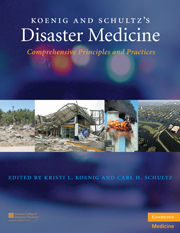Book contents
- Frontmatter
- Contents
- List of Contributors
- Contributor Biographies
- Foreword
- Preface
- Acknowledgments
- PART I CONCEPTUAL FRAMEWORK AND STRATEGIC OVERVIEW
- PART II OPERATIONAL ISSUES
- PART III CLINICAL MANAGEMENT
- SECTION A CBRNE AND HAZMAT
- 26 Explosive Events
- 27 Burn Patient Management
- 28 Clinical Aspects of Large-Scale Chemical Events
- 29 Biological Events
- 30 Nuclear and Radiological Events
- 31 Hazardous Material, Toxic, and Industrial Events
- SECTION B ENVIRONMENTAL EVENTS
- Index
- Plate section
- References
30 - Nuclear and Radiological Events
from SECTION A - CBRNE AND HAZMAT
Published online by Cambridge University Press: 05 August 2011
- Frontmatter
- Contents
- List of Contributors
- Contributor Biographies
- Foreword
- Preface
- Acknowledgments
- PART I CONCEPTUAL FRAMEWORK AND STRATEGIC OVERVIEW
- PART II OPERATIONAL ISSUES
- PART III CLINICAL MANAGEMENT
- SECTION A CBRNE AND HAZMAT
- 26 Explosive Events
- 27 Burn Patient Management
- 28 Clinical Aspects of Large-Scale Chemical Events
- 29 Biological Events
- 30 Nuclear and Radiological Events
- 31 Hazardous Material, Toxic, and Industrial Events
- SECTION B ENVIRONMENTAL EVENTS
- Index
- Plate section
- References
Summary
OVERVIEW
Large-scale Radiation Events: An Evolving Risk
Mass exposure to radiation does not occur frequently but when it does such events present significant logistical, operational, and medical challenges that may be compounded by the lack of familiarity most first responders and other medical personnel have with the manifestations and management of radiation injury. Because of the proliferation of nuclear states, the occurrence of at least one well-documented case of smuggling of nuclear technology, the widespread availability of radioactive materials, and continuing concerns about the risk of nuclear or radiological terrorism, the risk of deliberate mass exposures to radiation has likely increased in recent years. Additionally, there is an ever-present risk of mass radiation exposures, such as occurred after the Chernobyl accident and the 137Cs dispersion event in Goiânia, Brazil. The recent efforts of the United States and other nations to improve their capabilities to prevent or interdict nuclear smuggling, to enlarge the armamentarium of radiation countermeasures, and to disseminate information about the management of radiation casualties suggest the seriousness with which the threat of deliberate attack is regarded. Numerous authors have summarized the publicly available information related to this threat, and the interested reader is referred to these sources for more detailed accounts.
SCENARIOS OF CONCERN
Mass exposures to radiation may be accidental or deliberate in origin. Heretofore, all such incidents have been the result of accidents, with the notable exceptions of the exposures occurring as a result of the atomic bombings in Hiroshima and Nagasaki and the exposure of more than a hundred people to 210Po in the wake of the Litvinenko poisoning.
Keywords
- Type
- Chapter
- Information
- Koenig and Schultz's Disaster MedicineComprehensive Principles and Practices, pp. 477 - 510Publisher: Cambridge University PressPrint publication year: 2009
References
- 3
- Cited by



